Art has always been a powerful form of expression, an outlet for creativity, and a means of communication that transcends language barriers. In the 21st century, technology has reshaped nearly every aspect of our lives, and the art world is no exception. One of the most exciting advancements is [Bing AI Art], which blends artificial intelligence with creativity to produce breathtaking works. But what exactly is Bing AI Art? How does it work, and why should we care? In this article, we will explore the ins and outs of Bing AI Art, its benefits, challenges, and its impact on the future of creativity.
What Is Bing AI Art?
[Bing AI Art] is a unique art form created by leveraging artificial intelligence to generate artistic pieces, mainly using Microsoft Bing’s AI capabilities. It involves using sophisticated algorithms that understand patterns, colors, shapes, and aesthetics to produce visuals that resemble what a human artist might create. These pieces range from paintings to abstract art and often blur the lines between what is made by human hands and what is crafted by a machine.AI-generated art isn’t entirely new, but Bing’s innovative approach makes art accessible, customizable, and intensely interactive. With Bing AI Art, anyone—artists and non-artists alike—can collaborate with technology to bring creative visions to life. It’s like having an always-ready creative partner who never runs out of ideas.
How Does Bing AI Art Work?
To create [Bing AI Art], artificial intelligence relies on machine learning, deep learning models, and a vast database of images. Here’s how the magic happens:
- Data Collection: Bing’s AI collects an enormous amount of data from millions of images, analyzing styles, colors, and patterns. This data helps the AI learn how different art forms work.
- Machine Learning: Using machine learning, the AI is trained to recognize features of various art styles. For example, it can identify the difference between a Van Gogh painting and a digital modernist piece.
- User Input: Users can provide specific prompts or preferences. For example, you might type in “a sunset over a city in a surrealist style,” and Bing AI will generate a piece that aligns with that description.
- Image Generation: The AI then generates an image based on the input, creating something unique every time. It can blend multiple styles, try different color palettes, and produce different compositions, ensuring each artwork is distinctive.
The Rise of AI Art: A Brief History
Artificial intelligence and art may seem unusual, but their history dates back several decades. In the early days of computing, artists experimented with computer-generated graphics, but the outcomes were often limited by the technology of the time. Fast forward to the modern era, and we have the powerful Bing AI Art platform that creates visuals almost indistinguishable from those painted by human hands.
The use of AI in art took a significant leap with the development of generative adversarial networks (GANs) in 2014. GANs allowed AI models to create more realistic and creative images. Bing AI Art builds upon this technological foundation, using advanced models learned from vast data sources, making it capable of creating diverse and detailed pieces.
Why Is Bing AI Art So Special?
[Bing AI Art] stands out for several reasons, making it a fascinating tool for both artists and art enthusiasts:- Accessibility: One of the most significant advantages of Bing AI Art is its accessibility to the creative process. You no longer need years of training or expensive supplies to create art. All you need is an idea and access to Bing AI, and you’re set!
- Endless Creativity: Bing AI Art can help generate new ideas, inspire, or even collaborate in a way that sparks a new direction for an artist. It can be a muse, offering endless possibilities that might not have been considered otherwise.
- Customization: The user has control over the outcome. You can tell the AI your style, mood, and color preferences and watch it bring that vision to life. You become the creative director, guiding the AI to fulfill your imagination.
- Democratizing Art: Traditionally, creating art could be a long, arduous process requiring years of training. Bing AI Art democratizes art, allowing anyone to be an artist.
The Process of Creating Bing AI Art: Step-by-Step
Let’s take a closer look at how you can create your own [Bing AI Art]. The process is simple yet full of potential for creativity:
- Access Bing AI Art Tool: Access the Bing AI platform where the art tool is available.
- Input Your Idea: Type in what you want to see, such as “a landscape with mountains and a starry sky in impressionist style.”
- Adjust Settings: If available, tweak settings such as colors, mood, and brushstrokes.
- Generate and Review: Hit the generate button. The AI will process your input and create an image.
- Edit If Desired: If you’re not completely satisfied, you can iterate on the image, providing more instructions until you get it right.
- Download and Share: Once you’re happy, download and share your masterpiece!
Who Can Use Bing AI Art?
- Artists: Bing AI Art is a tool for artists who want to expand their toolkit. It’s not about replacing artists but enhancing their creative capabilities. Artists can use it to experiment with different styles, explore compositions, or simply brainstorm.
- Students: For those learning about art, Bing AI Art is a fantastic way to see various styles in action. It can also be educational, showing how a specific art movement might reinterpret an everyday object.
- Designers: Bing AI Art will be useful for designers looking to create quick concept art or explore multiple iterations before finalizing their work.
- Hobbyists: If you love to create but don’t want to spend years studying art techniques, Bing AI Art is perfect for experimenting and having fun.
Benefits of Bing AI Art
- Fosters Creativity: Bing AI Art acts as a springboard for creativity. The AI’s unique perspective often creates unexpected results, giving artists new exploration directions.
- Rapid Prototyping: Creating art traditionally can be time-consuming. With Bing AI Art, artists can quickly create multiple concept versions, saving precious time during brainstorming.
- Breaks Artist’s Block: One of the common struggles artists face is “artist’s block.” [Bing AI Art] is an incredible tool for overcoming this, as it can provide new and fresh ideas even when you feel completely uninspired.
A Look at Some Popular Bing AI Art Styles
Bing AI Art can replicate a wide range of artistic styles, including:
- Impressionism: Inspired by the works of artists like Claude Monet, Bing AI Art can generate soft, light-filled paintings that capture the essence of a scene.
- Surrealism: Imagine landscapes that look like they came straight from a dream. Bing AI Art can create strange and thought-provoking images in a surrealist style.
- Abstract: Abstract art created by AI often emphasizes color and form over recognizable shapes, resulting in vibrant and emotionally charged pieces.
- Photorealism: For those looking for images that look like a camera could have captured them, Bing AI Art can remarkably mimic realistic styles.
Here’s a table showing different styles and how they can be used with Bing AI Art:
Art StyleDescriptionPossible Uses
Impressionism Soft brushstrokes, light, and color interplay Landscapes, nature scenes
Surrealism Dreamlike, bizarre imagery Fantasy art, thought-provoking pieces
Abstract Emphasis on color and form Emotional expression, decorative art
Photorealism: Highly detailed, realistic imagery Concept art, visualization of real-world scenes
Ethical Considerations and Challenges
While [Bing AI Art] has exciting potential, it also comes with ethical concerns and challenges:
- Originality: One common criticism of AI-generated art is the question of originality. AI models are trained using existing images, and there’s a debate over whether the resulting art is genuinely “new” or just an advanced remix of past creations.
- Impact on Artists: Some artists worry that AI could replace them. However, viewing Bing AI Art as a tool that enhances human creativity rather than a replacement is more realistic.
- Copyright Concerns: Since Bing AI Art relies on a large dataset for training, there are copyright questions. If an AI is trained using copyrighted works, does that infringe upon the rights of the original creators?
Bing AI Art in Everyday Life
Art created by Bing AI is not limited to galleries or artists’ studios. It’s also finding its way into various aspects of our daily lives:
- Advertising: Marketing teams use AI-generated art to create unique ad campaigns that grab attention.
- Home Decor: Bing AI Art is a source of custom artworks people can use to decorate their homes. The ability to personalize pieces makes it a popular choice for interior designers.
- Education: Art educators use AI-generated works to teach students about different art styles and the interaction between technology and human creativity.
The Future of Bing AI Art
What does the future hold for [Bing AI Art]? Artificial intelligence is only getting more intelligent and more capable. In the coming years, we might see even more sophisticated tools that can:
- Understand Emotional Input: Imagine an AI that could detect your mood and create art based on your feelings that day.
- 3D Art and Virtual Reality: Bing AI Art could move beyond two-dimensional images to produce 3D models and immersive virtual environments, blending art with gaming and virtual experiences.
- Interactive Collaboration: In the future, artists might be able to collaborate in real-time with AI, where the AI not only follows instructions but actively contributes ideas.
Conclusion: Embracing the Future of Art
[Bing AI Art] represents a leap into a new frontier where creativity meets technology. It democratizes art, making it accessible to anyone with an idea. Whether you’re a seasoned artist looking for fresh inspiration or a beginner experimenting with creative expression, Bing AI Art provides endless exploration opportunities.While challenges like originality and ethical concerns exist, there is also tremendous potential for AI to enhance human creativity rather than compete with it. As technology continues to evolve, so too will our means of creative expression. [Bing AI Art] is not just a tool—it’s a new partner in our journey of artistic exploration.
Who knows? Maybe the next masterpiece to change the world will come not from a renowned artist but from a collaboration between the human mind and the endless creativity of Bing AI. It’s time to embrace this fascinating blend of art and technology and see where it takes us.



